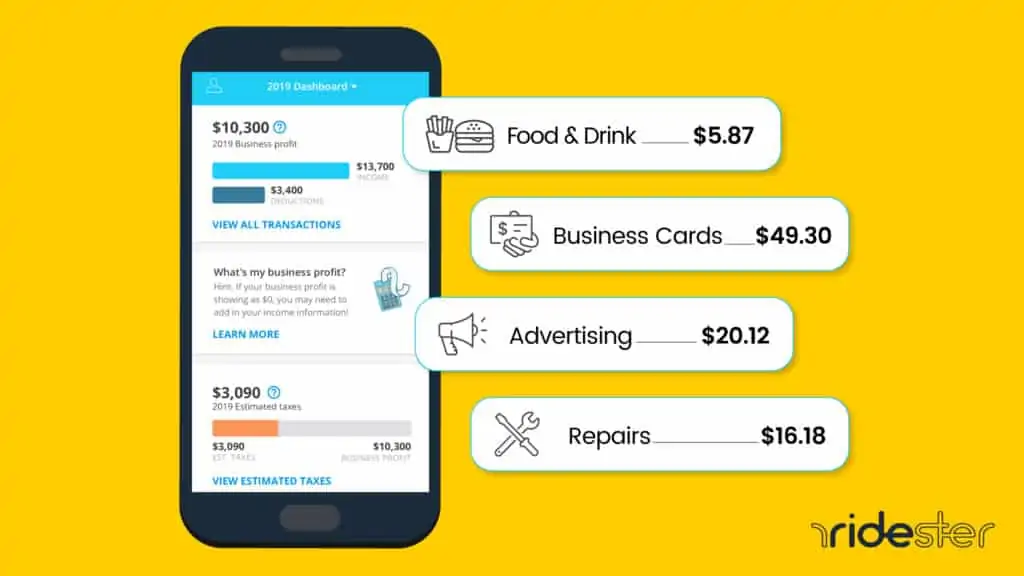It’s a common misconception that side hustles like rideshare driving exempts gig workers from tax commitments. The truth is that income earned by rideshare drivers for Lyft is subject to taxation, and drivers must report all their earnings accordingly.
As a Lyft rider, you are considered an independent contractor rather than a regular employee. You are solely responsible for paying your Lyft taxes because the company doesn’t withhold a certain amount from your earnings to cover your taxes.
While having tax obligations sounds like a chore, knowing how to track or report your income and file forms accurately is key to preventing tax penalties and audits from the Internal Revenue Service (IRS). Tracking your job-related expenses, including mileage, helps ease your tax commitment through deductions, too.
This comprehensive guide will navigate you through tax filing and management, the tax forms you’ll need, and how to deal with common tax issues.
Do Lyft Drivers Pay Taxes?
Yes, Lyft drivers do pay taxes. As independent contractors, they are responsible for reporting and paying both income and self-employment taxes. This includes contributions to social security and Medicare.
Lyft doesn’t withhold taxes from their earnings, so drivers need to monitor their income and pay taxes accordingly to avoid penalties. They must also handle their tax forms, such as 1099-K or 1099-NEC, and may qualify for deductions to reduce their tax bill.
Understanding Your Tax Obligations as a Lyft Driver
Lyft drivers are independent contractors who are also considered self-employed individuals, which means that taxing works differently for them, unlike regular employees.
As a self-employed individual, you’re both the employee and business owner, which means you’re responsible for paying tax portions for both.
Let’s compare how taxes work for regular employees and self-employed individuals to give a better understanding.
Independent Contractor vs. Regular Employee Tax
For those under regular employment, the company they work for deducts their taxes from their paycheck and sends it to the IRS on their behalf. Whereas independent contractors like Lyft drivers must make tax payments on an annual basis.
Because Lyft does not directly employ them, the company doesn’t automatically deduct taxes from their net pay. That’s why Lyft drivers must monitor their earnings and pay taxes accordingly to avoid penalties.
Lyft drivers are responsible for paying both income and self-employment taxes. Self-employment tax includes social security and Medicare contributions, while income tax is based on taxable income.
The taxable income is your total income subject to tax, independent of tax deductions and exemptions.
Essential Tax Forms for Lyft Drivers
Taxes also mean preparing several documents and forms, which are crucial to reporting self-employment income and deductions to the IRS accurately.
Lyft drivers usually receive 1099 forms from Lyft—either 1099-K or 1099-NEC (whichever applies). Plus, they should be wary of Schedule C and Schedule SE forms. Let’s discuss each:
1. Form 1099-K
Lyft drivers who gained at least $20,000 in gross ride earnings or have completed at least 200 rides in a calendar year receive this form.
The 1099-K contains the total amount paid for all rides made that year, including tips and other payments.
2. Form 1099-NEC
If form 1099-K encompasses your rideshare earnings, form 1099-NEC (NEC stands for non-employee compensation) reports your earnings outside your driving income.
1099-NEC replaced the form 1099-MISC. It includes amounts you’ve earned through incentives, promotions (like referral bonuses), and earnings independent of rideshare payments received from customers.
Lyst issues this form for drivers who made at least $600 in non-ride earnings.
3. Schedule C
The Schedule C form is where gross income, profit, and loss should be reported, so drivers must list all their earnings and work-relevant expenses (mileage, maintenance, phone bills, etc.) incurred here. This form should accompany Form 1040, the income tax return form.
4. Schedule SE
SE IRS stands for self-employment, and this two-part form tax form is where Lyft riders list and calculate their total taxable income for self-employment (Social Security and Medicare coverage). This form should also be filed with Form 1040.
It’s essential to note that even without receiving tax forms from Lyft by the end of the year, drivers are responsible for filing their income. These forms are also readily downloadable from Lyft’s Driver Dashboard and the IRS website.
Tax Deductions and Credits for Lyft Drivers
For tax deductions, Lyft drivers must track and file qualified expenses to reduce their tax bill. Every penny you spend while ridesharing, also known as your business expenses, is subject to deduction.
Here are the common deductions you can take advantage of:

1. Car and Mileage Expenses
Lyft drivers gain the most deductions from these expenses; that’s why it’s essential to keep all records, receipts, and documentation to justify your expenses aside from relying on Lyft’s online miles or logs.
Mileage and actual car expenses include:
- Fuel expenses
- Repair and maintenance
- Parking and toll fees
- Car insurance
The IRS’ current standard deduction for every mileage is 65.6 cents, and you can determine your mileage deductions by multiplying total business miles with the IRS rate. You can also add up your annual vehicle expenses while doing business.
Note that any mileage incurred outside of business hours can’t be deducted. This includes the miles covered when traveling home or running personal errands.
2. Mobile Expenses (Service Plans and Repairs)
Your service plan expenses, phone repairs, charging devices or other accessories, and even your mobile phone’s cost are subject to deduction. This is because your smartphone is a crucial element for doing business.
When you use the same phone for both personal and business transactions, deductions are only applicable for business-related mobile activity.
That’s why having a separate phone for Lyft driving makes deductions more manageable and easy to track. For this case, 100% of mobile expenses, including repair costs, are tax deductible.
3. Miscellaneous Expenses
Other expenses subject to deductions include:
- Lyft service fees
- Courtesy supplies to customers
- Roadside assistance plan fees
- Business licenses
- Safety supplies (first-aid kits)
- Other car tool kits
- Electronic toll transponder
- Lease payments
How to File Your Taxes as a Lyft Driver
The annual tax filing deadline occurs every 15th or 18th of April. Here’s everything you need to do when filing your taxes:
1. Prepare Your Personal Records and Annual Summary From Lyft
Your annual summary from Lyft doesn’t always contain all business-related expenses you’ve incurred for the year. So, you can use your personal records of business expenses and miscellaneous fees that aren’t included in your Lyft annual tax summary (statements, receipts, etc.)
Your personal records will also include your mobile service plan, parking and toll fees, and other business expenses.
2. Fill Out and Complete Your Tax Forms
Fill out your tax forms (1099-K, 1099-NEC, Schedule C, and Schedule SE) accordingly. Most of the details you’ll need to fill out will be provided by your Lyft annual tax summary.
Your Lyft tax summary contains details of your gross earnings, business-related expenses, and online mileage log. You can access this document from your Driver dashboard.
3. Prepare All Identification Cards and Supporting Documents
Apart from your tax documents, you may need to present the following upon filing: photo ID, taxpayer identification (TIN), social security number, tax return from the previous year, and Lyft’s EIN number.
4. Seek Help From Tax Professionals And Software Services (Optional)
To save you time and effort on tax filing, seeking professional services or using tax preparation software are your best resources.
Paying for software to complete tax forms is the more affordable option. Still, an accountant will not only aid in preparing your tax forms but will also give you personalized expert advice on managing your tax commitments.
Tips for Managing Taxes Throughout the Year
Apart from keeping track of your mileage business expenses and taking advantage of your Lyft annual summary to manage your taxes, making quarterly tax payments is one way to go.
By paying quarterly, you’re only paying estimated amounts for tax preparation services and your annual tax liability, which helps you avoid penalties involved with underpayment.
You can do so by making quarterly payments of at least 90% of your estimated tax for the present year. You can also use these quick bookkeeping tips to manage your taxes effectively:
- Record income
- Set apart personal expenses from business expenses
- Update and maintain inventories daily
- Keep invoices, statements, and other supporting documents to validate expenses
You can also use apps and tools to track your mileage (such as Stride Tax and Gridwise) and expenses. This will allow you to create financial projections for the coming tax season.
Dealing with Common Tax Issues
The IRS may audit your financial records randomly or if there are gaps in your income tax return. The best way to prevent audits is by staying truthful with your tax reports—avoid under-reporting your income or over-reporting your expenses for the sake of high deductibles.
It’s also quite common to receive a Backup Withholding Notice when there are issues with your TIN or personal information indicated on the tax return.
You should also ensure that all bank statements, receipts, and supporting documents are complete and valid. Mathematical errors, failure to sign returns, and typographical errors may subject you to auditing, too.
That’s why it’s essential to set aside money for taxes and seek professional help not to overlook these details.
Resources and Support for Lyft Drivers at Tax Time
The tax season can be overwhelming and costly; thankfully, Lyft’s rider support answers common tax filing questions.
Lyft riders also have the privilege of accessing free tax advice from TurboTax’s (Lyft’s official tax preparations partner) experts or may choose to avail of their filing services with a 25% discount.
Qualified taxpayers may avail of Free File from the IRS, which provides aid from guided tax preparation software.

